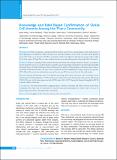Please use this identifier to cite or link to this item:
https://hdl.handle.net/20.500.14356/906Full metadata record
| DC Field | Value | Language |
|---|---|---|
| dc.contributor.author | Ghaju, Sajani | - |
| dc.contributor.author | Khadayat, Karan | - |
| dc.contributor.author | Shrestha, Raju | - |
| dc.contributor.author | Ghaju, Salan | - |
| dc.contributor.author | Manandhar, Trishna | - |
| dc.contributor.author | Marasini, Bishnu P. | - |
| dc.date.accessioned | 2023-04-05T06:24:08Z | - |
| dc.date.available | 2023-04-05T06:24:08Z | - |
| dc.date.issued | 2022 | - |
| dc.identifier.citation | GhajuS., KhadayatK., ShresthaR., GhajuS., ManandharT., & MarasiniB. P. (2022). Knowledge and DdeI Based Confirmation of Sickle Cell Anemia Among the Tharu Community . Journal of Nepal Health Research Council, 20(02), 454-459. https://doi.org/10.33314/jnhrc.v20i02.4158 | en_US |
| dc.identifier.uri | http://103.69.126.140:8080/handle/20.500.14356/906 | - |
| dc.description | Original Article | en_US |
| dc.description.abstract | Abstract Background: Sickle cell anemia is an inherited blood disorder caused due to a point mutation at the sixth codon of the ?-globin gene of both alleles. Sickle cell traits occur when the mutation is in one of the two alleles of the ?-globin genes. This study was carried out in the Tharu community, which is an indigenous and minority group mostly residing in the Terai region of Nepal. They are also considered as the most vulnerable group for inheriting Sickle cell anemia. Methods: Purposive sampling, which included 130 Tharu individuals of Kanchanpur district of Nepal, was considered for the study. The survey was conducted using a descriptive questionnaire that contained relevant information including the family history of Sickle cell anemia. This was followed by the analysis of blood samples to determine the prevalence of Sickle cell anemia and Sickle cell traits. Primer-mediated enzymatic amplification of target sequences in genomic DNA followed by restriction endonuclease assay with an enzyme DdeI was carried out for the confirmation. Results: Among 130 individuals, only 55.4% had basic knowledge about Sickle cell anemia. After screening for sickle cell anemia from 60 participants, 27 (45%) of them were found to be in the heterozygous state (carrier, Hb AS) and 28 (46.7%) were in the homozygous (normal, AA Hb) state with 5 (8.3%) having the diseased hemoglobin (Hb SS) variant of Sickle cell anemia. Conclusions: This study demonstrated a high prevalence of Sickle cell anemia and Sickle cell traits in the Tharu community. This study may be beneficial for concerned personnel policymakers to reduce sickle cell cases by improving genetic literacy among the Tharu community. Keywords: Hemoglobin; sickle cell anemia (SCA); sickle cell traits (SCT) | en_US |
| dc.language.iso | en | en_US |
| dc.publisher | Nepal Health Research Council | en_US |
| dc.relation.ispartofseries | April-June, 2022;4158 | - |
| dc.subject | Hemoglobin | en_US |
| dc.subject | Sickle cell anemia (SCA) | en_US |
| dc.subject | Sickle cell traits (SCT) | en_US |
| dc.title | Knowledge and DdeI Based Confirmation of Sickle Cell Anemia Among the Tharu Community | en_US |
| dc.type | Journal Article | en_US |
| Appears in Collections: | Vol 20 No 02 Issue 55 April-June, 2022 | |
Files in This Item:
| File | Description | Size | Format | |
|---|---|---|---|---|
| 4158-Manuscript-29696-2-10-20221104.pdf | Full Article. | 560.95 kB | Adobe PDF |  View/Open |
Items in DSpace are protected by copyright, with all rights reserved, unless otherwise indicated.
